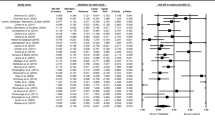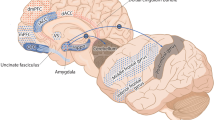Abstract
Successful diagnosis of PTSD has been achieved using neural correlations from prewhitened magnetoencephalographic (MEG) time series (Georgopoulos et al. in J Neural Eng 7:16011, 2010. doi:10.1088/1741-2560/7/1/016011; James et al. 2015). Here, we show that highly successful classification of PTSD and control subjects can be obtained using neural correlations from prewhitened resting-state fMRI data. All but one PTSD (14/15; sensitivity = 93.3 %) and all but one control (20/21; specificity = 95.2 %) subjects were correctly classified using 15 out of 2701 possible correlations between 74 brain areas. In contrast, correlations of the same but non-prewhitened data yielded chance-level classifications. We conclude that, if properly processed, fMRI has the prospect of aiding significantly in PTSD diagnosis. Twenty-five brain areas were most prominently involved in correct subject classification, including areas from all cortical lobes and the left pallidum.



Similar content being viewed by others
References
Alexander GE, DeLong MR, Strick PL (1986) Parallel organization of functionally segregated circuits linking basal ganglia and cortex. Annu Rev Neurosci 9:357–381
American Psychiatric Association (2013) Diagnostic and statistical manual for mental disorders, 5th edn. Author, Washington, DC
Blake DD, Weathers FW, Nagy LM, Kaloupek DG, Gusman FD, Charney DS, Keane TM (1995) The development of a clinician-administered PTSD scale. J Trauma Stress 8:75–90
Bluhm RL, Williamson PC, Osuch EA, Frewen PA, Stevens TK, Boksman K, Neufeld RW, Theberge J, Lanius RA (2009) Alterations in default network connectivity in posttraumatic stress disorder related to early-life trauma. J Psychiat Neurosci 34:187–194
Box GEP, Jenkins GM (1976) Time series analysis: forecasting and control. Holden-Day, San Francisco, CA
Brown VM, LaBar KS, Haswell CC, Gold AL, Beall SK, Van Voorhees E et al (2014) Altered resting-state functional connectivity of basolateral and centromedial amygdala complexes in posttraumatic stress disorder. Neuropsychopharmacology 39:361–369
Chen Y, Fu K, Feng C, Tang L, Zhang J, Huan Y, Cui J, Mu Y, Qi S, Xiong L, Ma C, Wang H, Tan Q, Yin H (2012) Different regional gray matter loss in recent onset PTSD and non PTSD after a single prolonged trauma exposure. PLoS ONE 7:e48298. doi:10.1371/journal.pone.0048298
Christova P, Lewis SM, Jerde TA, Lynch JK, Georgopoulos AP (2011) True associations between resting fMRI time series based on innovations. J Neural Eng 8:046025. doi:10.1088/1741-2560/8/4/046025
Cox RW (1996) AFNI: software for analysis and visualization of functional magnetic resonance neuroimages. Comput Biomed Res 29:162–173
DeLong MR, Georgopoulos AP (1978) The subthalamic nucleus and the substantia nigra of the monkey: neuronal activity in relation to movement. Soc Neurosci Abstr 4:42
DeLong MR, Georgopoulos AP (1979a) Physiology of the basal ganglia: a brief overview. Adv Neurol 23:137–153
DeLong MR, Georgopoulos AP (1979b) Motor functions of the basal ganglia as revealed by studies of single cell activity in the behaving primate. Adv Neurol 24:131–140
DeLong MR, Georgopoulos AP (1981) Motor functions of the basal ganglia. In: Handbook of physiology, the nervous system, brooks VB (volume editor), Brookhart JM, Mountcastle VB (section editors), Section 1, Volume II, Part 2. American Physiological Society, Bethesda, Maryland, pp 1071–1061
DeLong MR, Georgopoulos AP, Crutcher MD (1983) Cortico-basal ganglia loops. Exp Brain Res Suppl 7:30–40
DeLong MR, Alexander GE, Georgopoulos AP, Crutcher MD, Mitchell SJ, Richardson RT (1984a) Role of basal ganglia in limb movements. Human Neurobiol 2:235–244
DeLong MR, Georgopoulos AP, Crutcher MD, Mitchell SJ, Richardson RT, Alexander GE (1984b) Functional organization of the basal ganglia: contributions of single-cell recording studies. In: Functions of the basal ganglia, CIBA Foundation Symposium No. 107, pp 64–82
DeLong MR, Crutcher MD, Georgopoulos AP (1985) Primate globus pallidus and subthalamic nucleus: functional organization. J Neurophysiol 53:530–543
Engdahl B, Leuthold AC, Tan H-RM, Lewis SM, Winskowski AM, Dikel TN, Georgopoulos AP (2010) Post-traumatic stress disorder: a right temporal lobe syndrome? J Neural Eng 7:066005
Etkin A, Wager TD (2007) Functional neuroimaging of anxiety: a meta-analysis of emotional processing in PTSD, social anxiety disorder, and specific phobia. Am J Psychiatry 64:1476–1488
First MB, Spitzer RL, Gibbon M, Williams JBW (2002) Structured clinical interview for DSM-IV-TR axis I disorders, research version, non-patient edition (SCID-I/NP). Biometrics Research, New York State Psychiatric Institute, New York
Fisher RA (1958) Statistical methods for research workers, 13th edn. Oliver and Boyd, Edinburgh
Fox MD, Snyder AZ, Vincent JL, Corbetta M, Van Essen DC, Raichle ME (2005) The human brain is intrinsically organized into dynamic, anticorrelated functional networks. Proc Natl Acad Sci USA 102:9673–9678
Georgopoulos AP, DeLong MR (1978) The globus pallidus of the monkey: neuronal activity in relation to movement. Soc Neurosci Abstr 4:43
Georgopoulos AP, Tan H-M, Lewis SM, Leuthold AC, Winskowski AM, Lynch JK, Engdahl B (2010) The synchronous neural interactions test as a functional neuromarker for post-traumatic stress disorder (PTSD): a robust classification method based on the bootstrap. J Neural Eng 7:16011. doi:10.1088/1741-2560/7/1/016011
Hazrati LN, Parent A (1992) The striatopallidal projection displays a high degree of anatomical specificity in the primate. Brain Res 592:213–227
Hedreen JC, DeLong MR (1991) Organization of striatopallidal, striatonigral, and nigrostriatal projections in the macaque. J Comp Neurol 304:569–595. doi:10.1002/cne.903040406
Hedreen JC, Yin TC (1981) Homotopic and heterotopic callosal afferents of caudal inferior parietal lobule in Macaca mulatta. J Comp Neurol 197:605–621
Hoge CW, Castro CA, Messer SC, McGurk D, Cotting DI, Koffman RL (2004) Combat duty in Iraq and Afghanistan, mental health problems, and barriers to care. N Engl J Med 351:13–22
Hoge CW, Auchterlonie JL, Milliken CS (2006) Mental health problems, use of mental health services, and attrition from military service after returning from deployment to Iraq or Afghanistan. JAMA 295:1023–1032
James LM, Engdahl BE, Leuthold AC, Lewis SM, Van Kampen E, Georgopoulos AP (2013) Neural network modulation by trauma as a marker of resilience: differences between veterans with posttraumatic stress disorder and resilient controls. JAMA Psychiatry 70:410–418
James LM, Belitskaya-Lévy I, Lu Y, Wang H, Engdahl BE, Leuthold AC, Georgopoulos AP (2015) Development and application of a diagnostic algorithm for posttraumatic stress disorder. Psychiatry Res 231:1–7
Jin C, Qi R, Yin Y, Hu X, Duan L, Xu Q et al (2014) Abnormalities in whole-brain functional connectivity observed in treatment-naive post-traumatic stress disorder patients following an earthquake. Psychol Med 44:1927–1936
Kennis M, Rademaker AR, van Rooij SJ, Kahn RS, Geuze E (2015) Resting state functional connectivity of the anterior cingulate cortex in veterans with and without post-traumatic stress disorder. Hum Brain Mapp 36:99–109
Kessler RC, Berglund P, Demler O, Jin R, Merikangas KR, Walters EE (2005) Lifetime prevalence and age-of-onset distributions of DSM-IV disorders in the national comorbidity survey replication. Arch Gen Psychiatry 62:593–602
Kim SG, Hendrich K, Hu X, Merkle H, Ugurbil K (1994) Potential pitfalls of functional MRI using conventional gradient-recalled echo techniques. NMR Biomed 7:69–74
Lanius RA, Bluhm R, Lanius U, Pain C (2006) A review of neuroimaging studies in PTSD: heterogeneity of response to symptom provocation. J Psychiatr Res 40:709–729
Lanius RA, Bluhm RL, Coupland NJ, Hegadoren KM, Rowe B, Theberge J, Neufeld RW, Williamson PC, Brimson M (2010) Default mode network connectivity as a predictor of post-traumatic stress disorder symptom severity in acutely traumatized subjects. Acta Psychiatr Scand 121:33–40
Li X, Zhu D, Jiang X, Jin C, Zhang X, Guo L et al (2014) Dynamic functional connectomics signatures for characterization and differentiation of PTSD patients. Hum Brain Mapp 35:1761–1778
Liberzon I, Garfkinkel SN (2009) Functional neuroimaging in post-traumatic stress disorder. In: Shiromani PJ et al (eds) Post-traumatic stress disorder: basic science and clinical practice. Humana Press, New York, pp 297–317
Liu F, Xie B, Wang Y, Guo W, Fouche JP, Long Z et al (2015) Characterization of post-traumatic stress disorder using resting-state fMRI with a multi-level parametric classification approach. Brain Topogr 28:221–237. doi:10.1007/s10548-014-0386-2
Patel R, Spreng RN, Shin LM, Girard TA (2012) Neurocircuitry models of posttraumatic stress disorder and beyond: a meta-analysis of functional neuroimaging studies. Neurosci Biobehav Rev 36:2130–2142
Pruessmann KP, Weiger M, Scheidegger MB, Boesiger P (1999) SENSE: sensitivity encoding for fast MRI. Magn Reson Med 42:952–962
Rabinak CA, Angstadt M, Welsh RC, Kenndy AE, Lyubkin M, Martis B, Phan KL (2011) Altered amygdala resting-state functional connectivity in post-traumatic stress disorder. Front Psychiatry 2:62. doi:10.3389/fpsyt.2011.00062
Rauch SL, Shin LM, Phelps EA (2006) Neurocircuitry models of posttraumatic stress disorder and extinction: human neuroimaging research—past, present, and future. Biol Psychiat 60:376–382
Saad ZS, Glen DR, Chen G, Beauchamp MS, Desai R, Cox RW (2009) A new method for improving functional-to-structural MRI alignment using local Pearson correlation. Neuroimage 44:839–848
Seal KH, Bertenthal D, Miner CR, Sen S, Marmar C (2007) Bringing the war back home: mental health disorders among 103,788 US veterans returning from Iraq and Afghanistan seen at Department of Veterans Affairs facilities. Arch Intern Med 167:476–482
Snedecor GW, Cochran WG (1980) Statistical methods, 7th edn. Iowa State University Press, Iowa
Sripada RK, King AP, Garfinkel SN, Wang X, Sripada CS, Welsh RC, Liberzon I (2012) Altered resting-state amygdala functional connectivity in men with posttraumatic stress disorder. J Psychiatry Neurosci 37:241–249
Talairach J, Tournoux P (1988) Co-planar stereotaxic atlas of the human brain. Thieme, New York, NY
Van Hoesen GW, Yeterian EH, Lavizzo-Mourey R (1981) Widespread corticostriate projections from temporal cortex of the rhesus monkey. J Comp Neurol 199:205–219. doi:10.1002/cne.901990205
Wilson EB (1927) Probable inference, the law of succession, and statistical inference. J Am Stat Assoc 22:209–212
Yan X, Brown AD, Lazar M, Cressman VL, Henn-Haase C, Neylan TC et al (2013) Spontaneous brain activity in combat related PTSD. Neurosci Lett 547:1–5
Yeterian EH, Van Hoesen GW (1978) Cortico-striate projections in the rhesus monkey: the organization of certain cortico-caudate connections. Brain Res 139:43–63
Yin Y, Li L, Jin C, Hu X, Duan L, Eyler LT et al (2011) Abnormal baseline brain activity in posttraumatic stress disorder: a resting-state functional magnetic resonance imaging study. Neurosci Lett 498:185–189
Acknowledgments
This study was supported by a Service Directed grant from the US Department of Veterans Affairs, the University of Minnesota American Legion Brain Sciences Chair (A.P.G.), and the University of Minnesota Anderson Chair for PTSD Research (B.E.).
Author information
Authors and Affiliations
Corresponding author
Rights and permissions
About this article
Cite this article
Christova, P., James, L.M., Engdahl, B.E. et al. Diagnosis of posttraumatic stress disorder (PTSD) based on correlations of prewhitened fMRI data: outcomes and areas involved. Exp Brain Res 233, 2695–2705 (2015). https://doi.org/10.1007/s00221-015-4339-0
Received:
Accepted:
Published:
Issue Date:
DOI: https://doi.org/10.1007/s00221-015-4339-0




